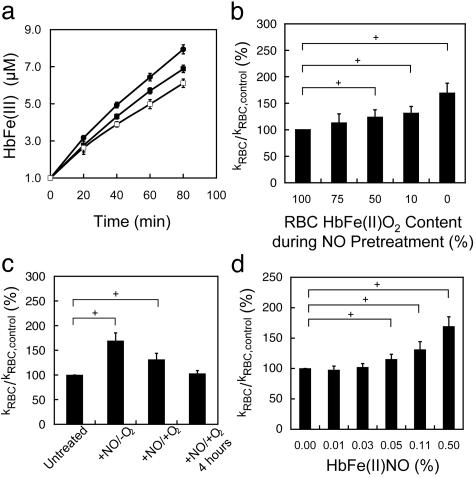Fig. 1.
Pretreatment of hypoxic RBCs with NO increased the NO consumption rate as measured by the competition assay. (a) The decreased production of HbFe(III) in the extracellular space suggested that NO was consumed more rapidly by hypoxic RBCs pretreated with NO (open squares) compared with untreated RBCs (filled squares). The total amount of NO released by the NO donor in the competition assay was measured by the formation of HbFe(III) in a solution of NO donor and cell-free HbFe(II)O2 (filled circles). (b) Conversion of HbFe(III) production to rates of NO uptake demonstrated hypoxic RBCs pretreated with NO consume NO more rapidly. NO entry into hypoxic RBCs pretreated with NO was more rapid than NO entry into untreated RBCs. Pretreatment of RBCs with NO under normoxic conditions (21% PO2) results in no change in the rate of NO uptake (P < 0.05, n = 4–8). (c) When tested under anaerobic conditions (+NO/-O2), the consumption of NO by NO-pretreated hypoxic RBCs increased 69 ± 16% (P < 0.01, n = 8). Reoxygenating RBCs pretreated with NO under hypoxic conditions by washing with oxygenated buffer and performing the competition assay under normoxic conditions (21% PO2) (+NO/+O2), the rate of NO consumption remained greater than that of untreated RBCs (31 ± 13%) (P < 0.01, n = 8). Washing NO-pretreated hypoxic RBCs with oxygenated buffer and incubating for 4 h (+NO/+O2/4h) reverted the NO uptake rate back to the untreated RBC rate of NO uptake (n = 4). (d) The increase in the NO uptake rate of NO-pretreated hypoxic RBCs correlated with the formation of HbFe(II)NO (P < 0.05, n = 4 for each sample).

